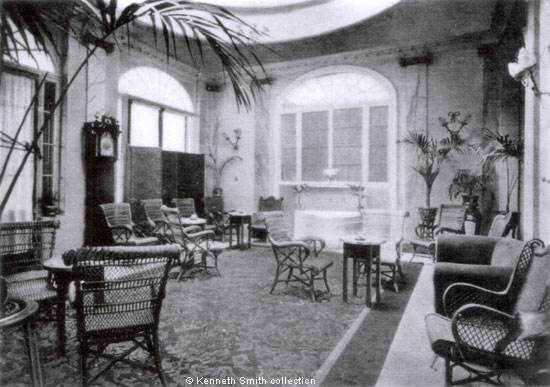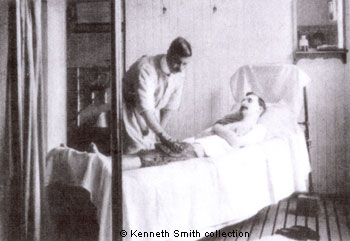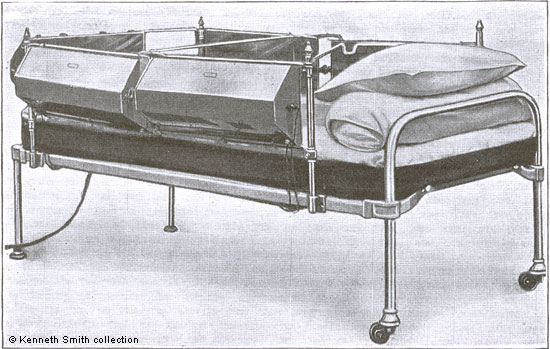|
Images Index> Matlock Bath, 20th and 21st Century Images> This page |
| Matlock Bath: Royal Hotel Brochure, about 1908 |
| Matlock Bath : Twentieth Century Photographs, Postcards, Engravings & Etchings |
|
|
||||||||||||||
The top picture shows the Entrance Hall to the Royal Hotel in the first decade of the twentieth century. The Royal Hotel's Hall is shown to have been light and airy, with light coloured walls (possibly white or cream), quite a contrast to fussy Victorian interiors. It was full of bamboo and wicker chairs, which were introduced in the Edwardian era. The hotel was lit by electric lights, also a relatively new introduction, and the cost was included in the room price. Fires in rooms, though, were an additional extra on the hotel bill. Prices were fixed at 1/6 [one shilling and sixpence] for a fire in a private sitting room during the day and 2/6 for a fire during both the day and night. Bedroom fires were slightly cheaper at 1/- [one shilling] for the day and 2/- for day and night.
A former guest described the hotel:
Meals were inclusive if you stayed for a week or more, otherwise
there was a charge, and Edwardian visitors could eat their
way through breakfast, lunch, afternoon tea and dinner. |
|||||||||||||||
 Details of possible activities and excursions for guests. |
|||||||||||||||
It is perhaps a slight exaggeration that the Golf Course was a few minutes walk from the Hotel (image 3)[1]. It would have been quite a hard climb up the hill to reach the links in Upperwood, and only a really fit person would have been able to do so in a few minutes. The quickest route would have been the path near the Speedwell Cavern. A slightly longer alternative would have been to climb the steps up through the grounds of the Palais Royal, reputed to number 365. So one for every day of the year! The Royal Hotel provided entertainment for its visitors and a Milanese String Band is mentioned above, led by Professor Avanzi. They played in the Lounge twice daily during the season. It was a similar band that had brought Romolo Tinti to Matlock Bath not long before. He returned to the village to marry and swore the Oath of Allegiance in 1907[2]. This brochure dates from around 1908, under Andreas Büttgen's management[3]. The hotel employed quite a few Europeans before the first World War, as did many other British hotels and restaurants. Although none are listed in the 1901 census, by 1911 the hotel staff included people from both Austria and Germany. They had perhaps been initially employed a few years earlier during Herr Büttgen's time at the hotel. In 1911 the Chef was George Heimworth who was born in Berlin and a Masseuse, Clara Anna Kunth, was from Leipzig[4]. A few years later, at the outbreak of war in 1914, locals were shocked when three German waiters from the hotel were arrested, taken to Matlock Police station and then to Derby before being allowed to return to Matlock Bath[5]. The Hotel could provide rooms for servants, if required, or a servant could stay in the same room as their master or mistress. Dogs could also stay with their owners, but were not allowed in public rooms. The charge for a dog was 1/6 per day. Some of the bath treatments were also included in the daily or weekly room tariff. Some of the hotel's charges are shown below.
|
|||||||||||||||
1 Treatments
available for female patients
2 Treatments available for male patients
Some of the images on the two pages have been enlarged below.
|
|||||||||||||||
Brochure advertising the Royal Hotel, Matlock Bath. No date but about 1908. With photographs by Percy Rowbottom. In the collection of and provided by and © Ken Smith. Images scanned for this website and information written, researched by and © Ann Andrews. Intended for personal use only |
|||||||||||||||
References (coloured links are to transcripts elsewhere on this web site or more information): [1] Matlock Bath Golf Course opened in 1903 but did not survive the First World War. [2] "The London Gazette", 3 December 1907. Also see Matlock Bath: Lovers' Walks and the Band Stand [3] A. Büttgen is in the brochure and he is listed as manager in Kelly's 1908 Directory. By the 1911 census Mr. Matthews had taken over at the Royal Hotel and Andreas Büttgen had moved to the Abernant Hotel, Llanwrtyd Wells in Brecknockshire. He was 34 in 1911, and had been born in Germany. His wife was from Belgium and two of their children were born in Matlock Bath. He subsequently moved to the Osborne Hotel, Langland Bay, near Swansea where a son was born but unfortunately got into financial difficulties ("Western Mail", 31 March 1914). He was released by the Official Receiver in 1915 (London Gazette, 24 August 1915). There are no further records but he does not seem to have emigrated. Andrew Büttgen possibly returned home, or even changed his name. It is likely that he would have been interned if he remained in Britain during WW1. [4] The 1911 census is available on Find My Past (link opens in a new window). [5] Beresford, Charles "The Bath
at War, A Derbyshire Community and the Great War" (2007).
Country Books/Ashridge Press. ISBN 978 1 901214 91 8.
|
|||||||||||||||

























